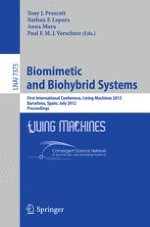2012 | OriginalPaper | Buchkapitel
How Past Experience, Imitation and Practice Can Be Combined to Swiftly Learn to Use Novel “Tools”: Insights from Skill Learning Experiments with Baby Humanoids
verfasst von : Vishwanathan Mohan, Pietro Morasso
Erschienen in: Biomimetic and Biohybrid Systems
Verlag: Springer Berlin Heidelberg
Aktivieren Sie unsere intelligente Suche, um passende Fachinhalte oder Patente zu finden.
Wählen Sie Textabschnitte aus um mit Künstlicher Intelligenz passenden Patente zu finden. powered by
Markieren Sie Textabschnitte, um KI-gestützt weitere passende Inhalte zu finden. powered by
From using forks to eat to maneuvering high-tech gadgets of modern times, humans are adept in swiftly learning to use a wide range of tools in their daily lives. The essence of ‘tool use’ lies in our gradual progression from learning to act ‘on’ objects to learning to act ‘with’ objects in ways to counteract limitations of ‘perceptions, actions and movements’ imposed by our bodies. At the same time, to learn both “cumulatively” and “swiftly” a cognitive agent (human or humanoid) must be able to efficiently integrate multiple streams of information that aid to the learning process itself. Most important among them are social interaction (for example, imitating a teacher’s demonstration), physical interaction (or practice) and “recycling” of previously learnt knowledge (experience) in new contexts. This article presents the skill learning architecture being developed for the humanoid iCub that dynamically integrates multiple streams of learning, multiple task specific constraints and incorporates novel principles that we believe are crucial for constructing a growing motor vocabulary in acting/learning robots. A central feature further is our departure from the well known notion of ‘trajectory formation’ and introduction of the idea of ‘shape’ in the domain of movement. The idea is to learn in an abstract fashion, hence allowing both “task independent” knowledge reuse and task specific “compositionality” to coexist. The scenario of how iCub learns to bimanually coordinate a new tool (a toy crane) to pick up otherwise unreachable objects in its workspace (recycling its past experience of learning to draw) is used to both illustrate central ideas and ask further questions.
